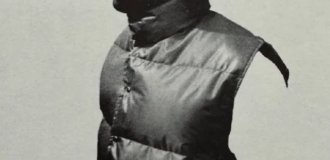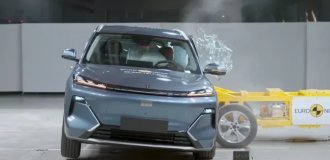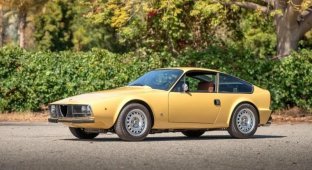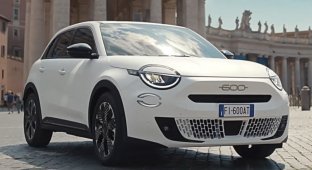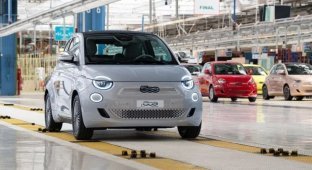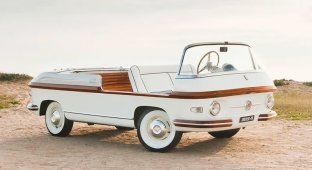Interesting and sometimes funny pictures on an automobile theme (21 photos)
Let's begin a fascinating journey through the history of automobiles and interesting vehicles. This century covers the birth of the automobile industry, the golden age of classic cars and a revolution in design and production. 
"Hunchbacked" is the nickname given to some models of the legendary Soviet car ZAZ-965 (Zaporozhets) due to the characteristic shape of the body. This car became a symbol of the Soviet small car.
The ZAZ-965 car was created at the Zaporizhzhya Automobile Plant (ZAZ) in the 1960s. Its development began after the signing of an agreement between the Soviet Union and the Italian company Fiat, which provided technology for the production of compact cars. Based on the Fiat 600, Soviet engineers created their own version of a small car, adapted to local conditions. 
1947 Davis Divan. A three-wheeled convertible produced by the Davis Motorcar Company from 1947 to 1949. During the entire existence of the company, only 13 Davis Divan cars were produced. Of these, only a few have survived, which today are rare exhibits for collectors and museums. 
Miss Young and her unusual vehicle. New York, 1920. 
A taxi driver with a gas cylinder on the roof of his car. Trondheim, 1917.
By the start of World War I, cars had become an important part of city life, but their dependence on gasoline created a vulnerability in wartime conditions. Gasoline was in short supply, its cost was rising, and supplies were becoming irregular. To keep going, many drivers looked for alternative energy sources for their cars.
One solution was to use natural gas or hydrogen as fuel. Gas cylinders were installed on the roofs of cars, allowing them to operate without gasoline. 
A GAZ-12 ZIM car in Gorky, 1959.
GAZ-12 "ZIM" is a Soviet executive car, produced by the Gorky Automobile Plant (GAZ) from 1950 to 1958. This car became a symbol of the Stalin era and the early Khrushchev period, combining luxury, power and technology for its time. It was intended for high-ranking officials, the party elite and foreign delegations. 
Photographer: Vladimir Nosakov
Ford "Comuta". Experimental electric car. England, 1967.
By the late 1960s, growing concerns about environmental issues such as exhaust pollution prompted automakers to begin exploring the possibilities of electric motors. The Ford Comuta was part of this global trend to reduce dependence on fossil fuels and find more environmentally friendly solutions.
The Ford Comuta was a small city car designed for short trips. The car was designed to accommodate one or two passengers, making it ideal for use in dense urban traffic.
The car was equipped with an electric motor powered by lead-acid batteries. The Comuta had a top speed of 64 km/h (40 mph). On a single charge of batteries, the car could travel about 64 km (40 miles). 
A tow truck on the Paris-Deauville highway, 1927. 
Citroën DS 19 Berline sedan, Moscow, Red Square, 1964.
The Citroën DS 19 Berline is a legendary French car that has become a symbol of innovation and advanced design in the automotive industry. Introduced at the 1955 Paris Motor Show, this saloon immediately caused a sensation with its futuristic appearance, unique technological solutions and revolutionary suspension system. It won the hearts of millions of drivers around the world and remains one of the most iconic cars of the 20th century. 
Dr. Manfred Curry stands next to his invention, the Curry-Landskiff, a human-powered vehicle that could reach speeds of up to 56 km/h, 1925. 
The RAF (Riga Bus Factory) plant in Jelgava, Latvia, 1992. After the collapse of the USSR, RAF began to experience problems with the supply of components and the sale of its minibuses. The photo shows incomplete "rafiks" being stored in areas around the plant. 
The Quasar-Unipower car, 1967. Designed by Vietnamese Nguyen Manh Khanh, later known as Quasar Khanh, and built by the British company Universal Power Drives Ltd., it was based on a shortened mini-frame with the engine mounted in the middle of the rear. Features included transparent seats and an automatic transmission. Only 6 cars were built. 
Rytecraft truck, Britain, 1953. 
Advertising photo of the Simca Aronde, 1953. 
Photographer: Robert Doisneau
Adler Trumpf, 1935. Fay Taylor in her Adler Trumpf, which she drove in the Eastbourne Rally. The Adler Trumpf was introduced in 1932 as a model aimed at the general public. The car combined modern technology, affordable price and high build quality. 
Photographer: E. Phillips
A woman driving a Packard Touing convertible through the Rocky Mountains, 1930s. 
Photographer: Armstrong Roberts
Advertising photo of the export version of the ZAZ 968. Ukrainian SSR, 1970s.
ZAZ-968 continued the traditions of its predecessors — ZAZ-965 and ZAZ-966, but at the same time received a more modern design and improved technical characteristics.
Differences from the non-export version: rear-view mirror on the left front wing, different design of the front seats and minor changes in the body (chrome was removed somewhere and ventilation slots for cooling the internal combustion engine were added). They were painted in a different color scheme. 
Bill Patrick and his track roadster, 1949. 
A car from the British TV series "UFO", 1970. 
"Velocar", pedal car. London, 1939. 
German micro-mobile "Mopetta", England, 1958.
Brütsch Mopetta - egg-shaped single-seater three-wheeled car, produced from 1956 to 1958 in a total of 14 copies. Maximum speed 35 km/h. 



